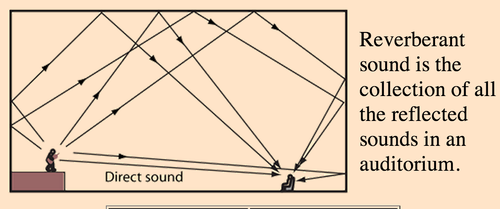Reverberation











Reverberation
Reverberation: The persistence of a sound in a big hail due to repeated reflections from the walls, ceiling and floor of the wall is known as reverberation. A short reverberation is desirable in a concert hall, where music is being played, as it boosts the sound level. But excessive reverberation is highly undesirable because sound becomes blurred, distorted and confusing due to overlapping of different sounds. To reduce reverberation, the roof and walls of the auditorium are generally covered with sound absorbent materials like compressed fibre board, rough plaster or draperies. The seat materials are also selected on the basis of their sound absorbing properties.
Application of reverbartion:
The phenomenoen of reverbration is utilized by the producers of living or recorded music in order to enhance sound quality.Several systems have been developed to produce and simulate reverbartion. A similar device is aplate reverberator, where a metal plate is used to produce vibartions instead of a loudspeaker.
Advantages of reverberation :
Reverberation do wonders when it comes to musical symphonies and orchestral halls, when the right amount of reverbartion is present, the sound quality gets enhanced drastically.
Disadvantages of reverberation :
Multiple reflection of sound sometimes results in inability of the listener to listen clearly .This is because he tends to hear both the direct sound and the repeated reflected sound waves.

How to reduce reverberation ?
1 Acoustic foam :Acoustic foam explicitly built to reduce the echoes and reverberations in music production studios and vocal recording booths.
2. By adding furniture to the room : Large soft items can absorb and nullify the energy that's propelling a sound wave. One easy and effective way of adding lots of large and soft items to your room is by adding large furniture.
3. By covering windows with curtains :By covering upthe windows with sound absorbing curtains, we can easily and asthetically reduce the amount of echo any room is experiencing .
4. Art and tapestries: The effect of echo can be reduced by using art and paintings on the wall .These a pintings helps in absorption of sound and reduces the echo.
5. Use of fabric blinds: These can be used to reduce the echo as well. They are usually made up of metal and wood ..
Match the following and choose the correct answer.
| |||||||||||
| Right Option : C | |||||||||||
| View Explanation | |||||||||||
The disadvantages of reverberation are ______________ . | |||
| Right Option : C | |||
| View Explanation | |||
We can reduce reverberation by _________________ | |||
| Right Option : D | |||
| View Explanation | |||
Students / Parents Reviews [10]
One of the best institutes to develope a child interest in studies.Provides SST and English knowledge also unlike other institutes. Teachers are co operative and friendly online tests andPPT develope practical knowledge also.

Aman Kumar Shrivastava
10thAbhyas is a complete education Institute. Here extreme care is taken by teacher with the help of regular exam. Extra classes also conducted by the institute, if the student is weak.

Om Umang
10thIt was a good experience with Abhyas Academy. I even faced problems in starting but slowly and steadily overcomed. Especially reasoning classes helped me a lot.

Cheshta
10thA marvelous experience with Abhyas. I am glad to share that my ward has achieved more than enough at the Ambala ABHYAS centre. Years have passed on and more and more he has gained. May the centre flourish and develop day by day by the grace of God.

Archit Segal
7thBeing a parent, I saw my daughter improvement in her studies by seeing a good result in all day to day compititive exam TMO, NSO, IEO etc and as well as studies. I have got a fruitful result from my daughter.

Prisha Gupta
8thMy experience with Abhyas is very good. I have learnt many things here like vedic maths and reasoning also. Teachers here first take our doubts and then there are assignments to verify our weak points.

Shivam Rana
7thAbout Abhyas metholodology the teachers are very nice and hardworking toward students.The Centre Head Mrs Anu Sethi is also a brilliant teacher.Abhyas has taught me how to overcome problems and has always taken my doubts and suppoeted me.

Shreya Shrivastava
8thMy experience with Abhyas academy is very good. I did not think that my every subject coming here will be so strong. The main thing is that the online tests had made me learn here more things.

Hiya Gupta
8thI have spent a wonderful time in Abhyas academy. It has made my reasoning more apt, English more stronger and Maths an interesting subject for me. It has given me a habbit of self studying

Yatharthi Sharma
10thMy experience was very good with Abhyas academy. I am studying here from 6th class and I am satisfied by its results in my life. I improved a lot here ahead of school syllabus.
